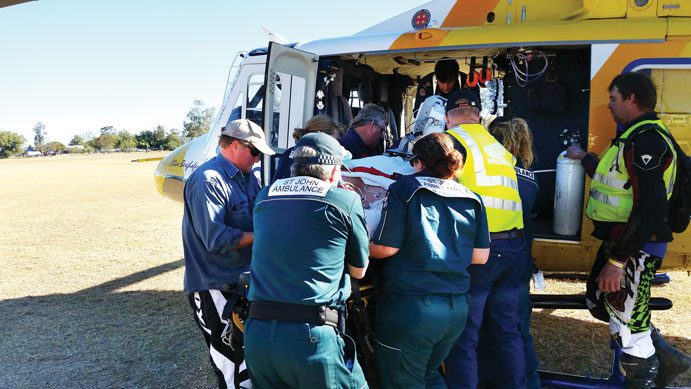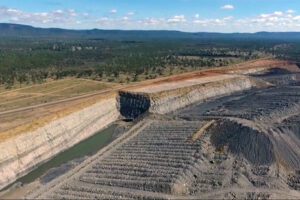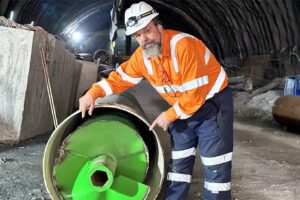The mining industry in Australia, through innovation, risk identification, use of meaningful safety indicators and the sharing of information sits proudly in the global mining industry with one of the lowest fatality rates in the world.1
Paramedics and nurses are now common place in most mining environments; mines rescue and safety teams train rigorously to deal with any unforseen accident or incident that may occur.
All this helps Australia maintain an exceptional safety record in the mining industry. However, it also makes the industry complacent in the need to keep more basic first aid skills up-to-date.
In sudden cardiac arrest and serious injuries, minutes – even seconds, can mean the difference between life and death. Ensuring workers know what to do in those first few minutes until more definitive aid arrives, can change the final outcome.
St John Ambulance Mines Nurse and Medic Annette Harrison says it’s not just about knowing what to do in a major incident, but also recognising and responding to illness and medical conditions.
“In the mining industry, serious incidents that relate to medical emergencies are far more common than incidents relating to trauma,” Annette said.
“Recognising the symptoms and signs of asthma, anaphylaxis, diabetes, epilepsy, stroke and heart conditions, and being able to respond appropriately and quickly, are basic skills that save lives.
“First aid, in many of these cases, is about the early recognition by the first aider that a more significant health event is taking place, and getting more definitive medical aid involved early to facilitate better casualty outcomes,” she said.
For the past two years St John Ambulance (Qld) has been delivering paramedical and nursing services across vast areas of Queensland on multiple contracts in the mining and resources sector. Over that period, St John paramedics and nurses have intervened and saved the lives of numerous workers. In most cases, the lives saved were not from trauma related incidents but from medical related emergencies.
The St John approach has always been to provide education through ‘toolbox talks’ at sites where paramedics and nurses are deployed. These entail providing basic first aid tips to workers, so that in the event of an emergency everyone knows what to do.
In early 2013, the value of this practice was highlighted when the workmates of one employee identified that she was experiencing some form of allergic reaction. They diverted the employee from her intended plan of heading to bed, and presented her to the St John nurse and paramedic on-site. Within a very short period, the employee experienced a significant anaphylactic reaction. The St John members involved were able to stabilise the casualty before she was airlifted to hospital.
So what first aid training is the best, what first aid level is right? Many readers might remember the simple pre-vocational education and training (VET) days of first aid, when Senior First Aid and Occupational First Aid were the courses of choice for most employees.
Under the VET environment there have been many changes to first aid, and it is an area that will continue to evolve with both compliance and clinical changes shaping what first aid courses look like.
Accredited VET first aid training will always play an important part of the first aid training that staff require to deliver first aid in the workplace.
Currently, the unit of competency, HLTAID003 Provide First Aid, is considered the all-round base level course that equips participants with the knowledge and skills to deliver basic first aid.
But does all first aid training need to be from the VET environment?
“In most cases, choosing an off-the-shelf course from an accredited registered training organisation (RTO) and delivering that to a number of staff based on identified risks is the approach most of the industry takes,” Annette said.
Other options do exist, not all training must to be from the VET sector; a blended approach of accredited training and non-accredited awareness training can be a great way to get the basic skills that save lives to a wider audience.
“Using methods such as ‘toolbox talks’ at staff meetings or any time the employees are together, and delivering targeted specific non-accredited training can be a great way to get first aid knowledge to the masses.”
Targeted non-accredited training also provides the opportunity to tailor the training to the risk, for example in environments where heat illness is a significant risk, having a portion of the workforce trained to the full accredited first aid training level and ensuring all remaining staff are trained in heat illness recognition and management through short ‘toolbox talk’ sessions, offers a more comprehensive approach to having staff prepared to deal with an identified risk.
The benefits of training more people through a blended approach of accredited and non-accredited training could also have a significant flow-on effect to the safety of the workforce.
In a literature review of the relationship between first aid training and injury rates by the Alberta Centre for Injury Research it was stated: “Nearly thirty years of study regarding the effect of first aid training on injury rates in specific populations shows that there is evidence that first aid training can change both attitudes and safety behaviours. Stronger evidence exists for the workplace than the general community and first aid training combined with safety training appears more beneficial than first aid training alone.”
So what are the good basic skills than can help? What are the things that if we all knew to do in an emergency, could make a difference?
The DRSABCD action plan
Annette says the first and most important thing mine and heavy industry workers should know, is how to respond to and prioritise in an emergency situation.
Checking for Danger
Checking for Responses
Sending for help
Making sure the Airway is open
Checking Breathing
Providing CPR and
Completing the chain of survival with Defibrillation if required.
In heavy industry and mine sites, vehicle accidents are still one of the most frequent type of traumatic accident that occurs. In road accidents, fatalities are most commonly caused by the victim suffering from an anoxia – loss of oxygen supply – caused by a blocked airway.2 On average it takes less than four minutes for a blocked airway to cause death.3
Keeping the chain of survival intact is the single most important step in survival from cardiac arrest. Research has shown that for every minute defibrillation is delayed the chance of survival reduces by 7% – 10%.4
Bleeding management
The average adult has between six to eight litres of blood circulating through their body.
“A loss of as little as 500ml can cause shock, which if left untreated can lead to death,” Annette said.
The simple steps of applying pressure and elevating the wound, if possible, can control bleeding and buy time. This is particularly important in industry sites where immediate medical aid may be restricted.
Burns
Burns are a common injury in heavy industry sites and can be extremely painful, Annette explains.
“The added complications of increased infection rates and the mental health issues surrounding severe disfigurement and disability, makes the quick treatment of burns paramount,” she said.
Cooling the burnt area with water, and covering it with a sterile non-stick dressing can greatly reduce the severity of the burn and speed the recovery process.
During Annette’s last deployment with St John, she treated a large number of burn injuries. Interestingly, most of the significant incidents did not occur on the project itself, but came from farmers and workers at surrounding properties.
Thanks to the good basic training staff had received in the toolbox sessions, by the time Annette reached the incidents, she knew casualties would have had the burns cooled and covered, so she could work on managing the pain and arranging evacuation.
Fractures, dislocations and soft tissue injuries
These types of injuries are extremely common in the workplace, and can cause lengthy time away from work if not treated properly.
Initial RICE management, (rest, ice, compression and elevation) can reduce the severity of soft tissue injuries and speed the recovery process.
Annette said basic first aid management of supporting and immobilising fractures or dislocations helps to reduce the pain of the injury and therefore the shock.
When managing casualties in remote locations – either through the location itself or other situations such as bad weather and flooding – simple first aid situations can suddenly become more complex. Having staff trained with good basic first aid skills can make a difference in these scenarios. Also in entrapment and confined spaces, having staff there on the scene who have the skills and knowledge to manage the situation in the initial moments until more definitive help arrives can make a big difference to the outcome.
Environment
Australian remote areas are often subject to extreme weather changes, from sweltering heat to bitter cold. Annette says that while not common, deaths from heat-related illnesses occur each year in Australia. Early intervention by first aid, in most cases, will save the life of a person suffering from over or under exposure to heat.
Basic first aid knowledge in the recognition of the difference between mild heat illness, heat exhaustion and fatal heat stroke, and commencing early intervention in extreme cases of over exposure to heat can reverse the situation, or, at the very least lessen the impact and save a casualty’s life.
Annette says simple skills save lives.
“Look at your risks and provide a level of training suitable to respond. Consider a blended approach to meet your first aid training needs,” she said.
In most environments, providing the minimum number of trained-accredited first aiders may not be meeting your true first aid requirements. Non-accredited awareness training, delivered through toolbox or other mediums where staff are together (even for short periods of time) helps provide the basic skills to meet risks. This way, a wider audience is reached and a higher standard of care can be given.
References
‘Evaluation of occupational safety and health in surface mines’, Safety Science, 46(6), 1016-1024. (Ural and Demirkol, 2008)
Fiander, S., 2001, ‘Anyone can save a life – Road Accidents and First Aid’, The British Red Cross, London.
Global Road Safety Partnership, 2003, FOCUS: First Aid: it saves lives on the road
Cummins RO, et al. Guidelines 2000 for Cardiopulmonary Resuscitation and Emergency Cardiovascular Care (ECC, Circulation (Suppl) 2001;102:8, August 22
Literature Review of the Relationship between First Aid Training and Injury Rates. July 2006 Alberta Centre for Injury Research














Add Comment